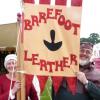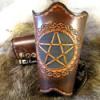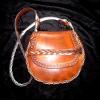-
Posts
1,904 -
Joined
-
Last visited
Content Type
Profiles
Forums
Events
Blogs
Gallery
Everything posted by UKRay
-
My workroom is a confused mess right now because I'm too busy to tidy up and there is far too much stuff in there. I might get around to a clear out in March or April - we'll see! What isn't too obvious is that there are different 'work-stations' for different activities. For example there is a tooling area, a staining area, a cutting area with a green cutting board, a hand machine area, a harness stitching area and a soft leather stitching area. I just wish I had three times the space! There is another area for heavy presses and cutting machines downstairs on the ground floor but that really is full of junk... Ray
-

Dye
UKRay replied to Gawa's topic in Dyes, Antiques, Stains, Glues, Waxes, Finishes and Conditioners.
Gawa, I would agree with Kate that her dye method would work well, but I tend to use a variation on this method because IMHO it is quicker and works better in a production setting where I have twenty items to dye and not one very special one. Try it and see if it works for you. I begin by dying the background color (normally the lighter colour) with either a sponge, dauber or soft cloth depending on size. When I get to areas that need to be a different colour I overlap into them by a half-inch or so. The trick is not to make the overlap area too dark so a single coat of dye is usually enough. To get the contrasting color over the embossed sections I start by cutting an approx. 12" square of cotton T-shirt material (good job I'm extra-large!) and wadding it tightly to form a hard pad. I then place the pad on the opened dye bottle and invert so the pad gets a shot of dye. I don't want it too wet as that would mean the dye would run into the embossed pattern, in fact I often blow on the pad to evaporate off some of the moisture. I then start at the edge of the work and gently (using an almost dry pad) start to rub the dye onto the work where I want the color to appear. I generally start at a place that doesn't have any embossing to be sure the pad is dry enough before progressing to the embossed section. To get a nice dark colour simply rub harder so more dye hits the work. To get the faded look around the edges just rub more gently. It really is as simple as that. Take your time and experiment. Ray -

10 meter single piece dog training lead
UKRay replied to Three Gun's topic in Leatherwork Conversation
It has to be 'spiral cut' if it is a single piece. I don't know about the guys in Texas, but we don't grow cows that big over here in the UK LOL (can you imagine the price of leather if we did?). Ray Maybe GM has a place after all... -
I was planning on looking at the sewing machine, Steve. You were just an added bonus! Isn't it about time you produced one of these for Cobra? Ray
-
I have been after one of these for ages and would be happy to pay shipping and reasonable costs for a copy. Please send me a PM if you have a spare. Many thanks, Ray
-
A couple of days ago I read this in another post: "...the average (working) leatherworker has about 15 grand in tools in the shop...". It prompted me to sit down and value the contents of my shop and store and I was both delighted and horrified by the figure I came up with. I've got a fair number of old machines in my shop that are pretty well worthless to anyone else and a couple of almost new sewing machines that have some value. I have a fair sized (but not massive) collection of well used hand-tools, some newer small machinery and some leather. In addition I have a stock of finished goods that I take to shows and sell. I have calculated that I was under-insured by a factor of 10... I only moved into my current shop a couple of years ago so I can't quite believe where all this 'stuff' has come from and how much it is all worth. Are you in the same situation? Tell us about it? How much is your shop really worth? Ray
-
I have recently started using an old adjustable 'anglepoise' light fitted with a daylight photography bulb that gives out a huge amount of clean white light. The light bulb was more expensive than usual but not too outrageous. It is so good I have purchased another for my staining bench and one for my cutting table. Specification follows: Daylight 35w (175w) 5400k E27 Umbrella Top Bulb which according to the sales blurb means it is a 35w bulb equal to 175w output with 5400k daylight balanced neutral color and is 80% energy saving The older I get the more I seem to need good light to work in, I haven't used anything as good as this before and am most impressed. Ray
-
Thank you all for the helpful suggestions and the links to useful information. I'm almost there! I'm off to Ironbridge to talk to Blists Hill next week, Terry. I watched the Victorian Christmas TV programme from Acton Scott (which is just up the road from me) and was amazed by the shops and workshops they visited there. Ray
-
Alan, I'm not quite sure what you are up to here or what your personal problems with Art might be. I just know that your public comments just went a tad too far for my liking. If you want to PM me to explain I'd be happy to hear you out and act on any reasonable complaint you may have. For the benefit of those who don't know, Art is not a 'self-proclaimed expert' he was simply asked (press-ganged is probably nearer the truth) to pick up sewing machine enquiries on this forum as his knowledge of sewing machinery is waaaay better than most of us non-technical leather folk. He gives a huge amount of his time free of charge to help you folks and doesn't need pointless unpleasantness in return. Now if you can all go back to playing nicely please, we'll carry on... Ray
-
Just send me a few pics and I'll gladly let you know! Ray
-

What is the purpose of spinning a glass cylinder over a piece of
UKRay replied to antipaladin's topic in Leather Tools
I may be wrong, but it seems that you have two ideas fighting for supremacy here. When a side of leather is being finished it goes through a process called 'plating' which essentially means it gets a good ironing and all the wrinkles are flattened out and the surface is made nice and even. It also flattens the leather down a lot and gives it more body. The plating machine I have seen working most recently is at Collyton in Devon, UK and was frankly terrifying to watch. It was a massive cast iron construction fitted with a rotating cylindrical 'iron' on a traveller which allowed the operator to flatten out the hide from one end to another. The other process is called slicking which is often carried out by top class saddlers and involves a glass 'slicker' or scraper that flattens and smooths out the surface of the hide and gives it a beautiful texture. An interesting side effect of plating is that the leather becomes harder to work - several continental European tanneries plate their leather to within an inch of its life and he resulting hides are very difficult to cut because they have such a hard surface. The tannery at Collyton is guilty of the same thing and I have a hide hanging in my workshop that is so hard I can't use a knife on it safely. I have to cut it with the clicking press. Anyway if that helps I'm pleased but you are welcome to ignore it! Ray -
I'm primarily looking for construction patterns for small leathergoods including cases, quivers, pouches and purses. I guess my idea was to draw together the best designs I could find and offer my 'version' of them to my customers. I am particularly keen to find very simple designs that are functional and attractive. I'm looking more for machine stitched projects rather than hand stitched - my customers don't have a lot of money to spend, but if you have a hand stitched project that is exciting then please send it along. My preferred 'genres' include: Bushcraft items 'Pocket' items (such as key cases, phone cases etc) Music items (instrument straps, penny whistle holster, etc) industrial items (tool cases, etc) 'Belt' items - (folding knife cases, pouches etc) but I'm happy to hear any other ideas If you have any ideas then maybe the best move is to send me a picture of the completed item and your price for the construction pattern (this image can be of a prototype). This will not compromise your design and if I like what I see; and the drawings/instructions are workable then we can talk money. At this point I should probably point out that I am not prepared to pay anywhere near £150 for a design unless I were to purchase the exclusive rights to it and I was convinced it was capable of bringing in a PROFIT of £1500 in 12 months - IMHO, I don't need exclusive rights to anything so if you sell it to me then you can sell it to others as well. Maybe there is a new industry here? Hope this clarifies things further. Ray
-
What a very helpful set of answers. Many thanks all. Has anyone got anything else to add? What size do you cut your wristbands to? How long does a braided wristband need to be cut so it is the right length after braiding? Is there any kind of formulae? Ray
-
I'm keen to expand my range of small leathergoods but don't have the time to create new product designs/patterns. If you have developed an exciting new design/pattern for a leather item and would like to sell a copy to me (remember that I am a pro-maker) then please get in touch so we can discuss an appropriate price. Please note: I am only keen to buy NEW patterns so please don't send me any you have copied from somewhere else. I'm only interested in new and original work. Just to make this perfectly clear - I'm looking for new product ideas and patterns - not tooling patterns. Ray
-
I've spent the past couple of weeks thinking that I ought to standardize the size of some of my products to save production time and make pricing easier. Things I sell all the time (like narrow wristbands) could be cut out simply and easily in advance and finished to order. But what size should they be? I have a very large wrist that measures almost 8.5" round but a lady's wrist can be as small as 6", whilst a child's wrist can be even smaller than that so how many sizes do you think I should I make and what should they be? Anyone got any thoughts on this? All suggestions gratefully received! Ray (Could someone please measure a passing child and let me know how small its wrist is please - my own little lad is 25 now and somehow, I don't think he qualifies!)
-
Great question, John. I'd like to get some custom wheels made for my Tippmann embossing machine but don't know where to start looking for a maker. Ray
-
Yup, those were they... I guess I'll have to wait 'till after the holiday to place an order. Shame, 'cos I need them tomorrow! Thanks BWL and thanks as always, Luke. It must be great to have that old Weaver catalogue etched into your brain - total recall. Outstanding... LOL Ray
-
I had a feeling it was pretty old... but I didn't think it was THAT old! LOL
-
The whole Victorian fair thing is getting quite big and I have need to find myself some kind of Victorian costume so I look the part, even if my work is not quite on the same timeline. Essentially, I'm having problems finding a sensible costume that: doesn't make me look any more of a dork than I do already... don't go there! allows me to move around and work at a bench all day. is appropriate to the time period. My first thought was to do the steampunk thing, but that was stomped out of me by several show organisers who visualise things rather differently to me. My question is simple: what would a Victorian leatherworker have worn? Ray
-
The gadgets I'm looking for are used to clamp the end of a piece of leather to the bench whilst cutting or possibly stretching straps. The trouble is I don't know what they are called. Has anyone got any idea? More importantly, where can I get a couple? Thanks. Ray
-
A few more for you: Invest in a bottle of silicon oil to put on the felt thread greasing pad that you will find on most flatbed machines. It really makes a difference to the thickness you can stitch and has made my machine a lot more versatile. I invested in a bunch of spare bobbins which I keep filled with the various colors of thread I use most. I find two of each color is most useful and can save me a lot of time in the middle of a job. I always use the same thickness thread on my flatbed machine and buy spools two at a time. I keep the four most popular colours: brown, black, natural and yellow on a stand in pairs. Ray
-
I guess the same rules apply when you stitch heavier leather? I'm planning to use 3mm thick veg tan to make a gusseted satchel - so two pieces is pretty hefty. I wouldn't think a stapler would hold the pieces together but I'm happy to use tack ties as long as the holes can vanish under the stitching. I've had a try at stitching gussets before and found I had cut the gusset too short. It is probably a trial and error thing but it would be helpful to hear suggestions on how to get the gusset to line up with the bag front and back. Do I need to start stitching in the middle and work to each side? Should I stitch the back to the gusset first or the front? Does it matter? Ray
-
Many thanks guys. Dave, that tutorial is excellent and extremely helpful. I've got a much better idea of what is involved now and I'll be back to you if I get stuck (and with my track record for glue spillage that could be very soon!). One thing I did notice is that you hand stitch your sheaths and I wondered if a heavy harness sewing machine would make the job easier? Ray
-
I wonder just how old that story is? Ray















